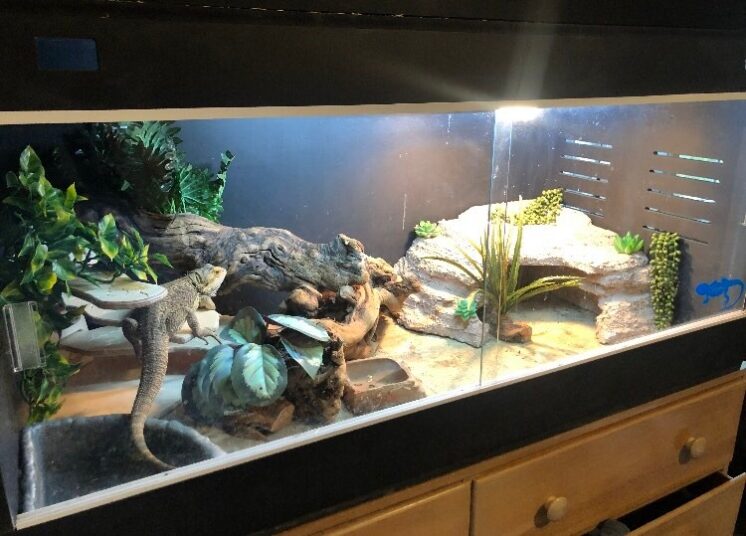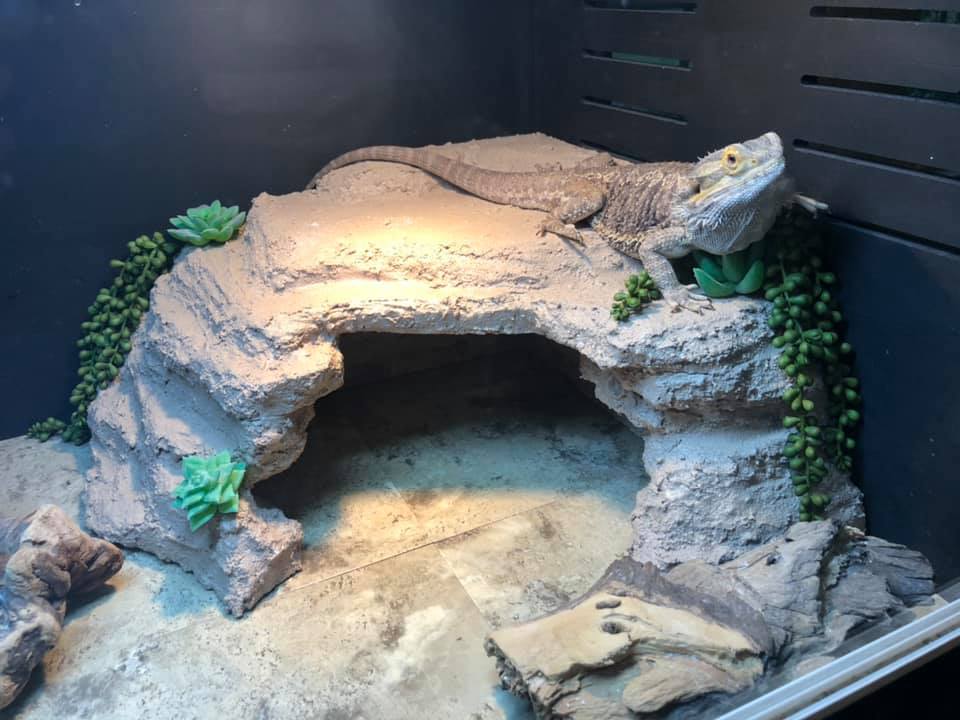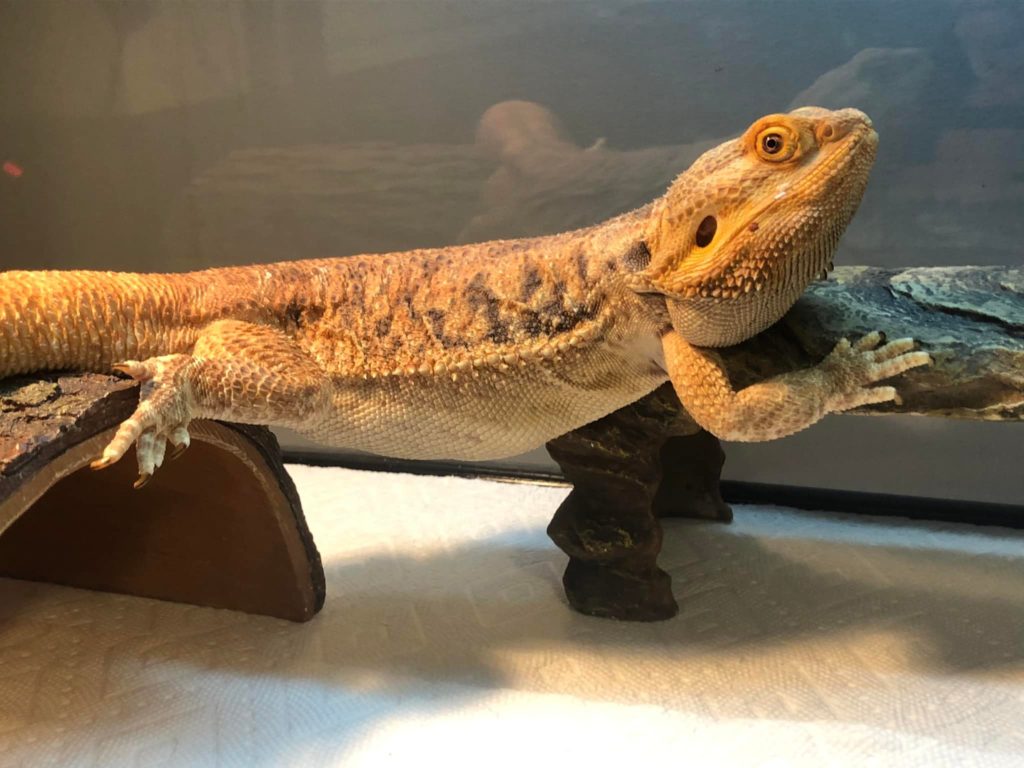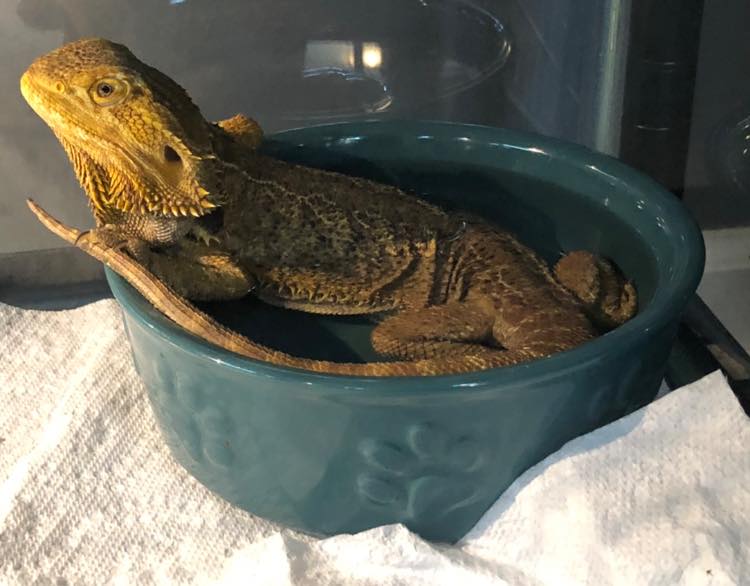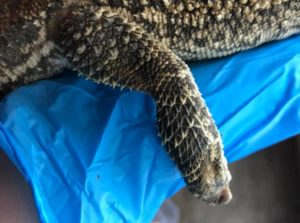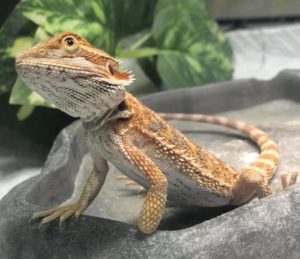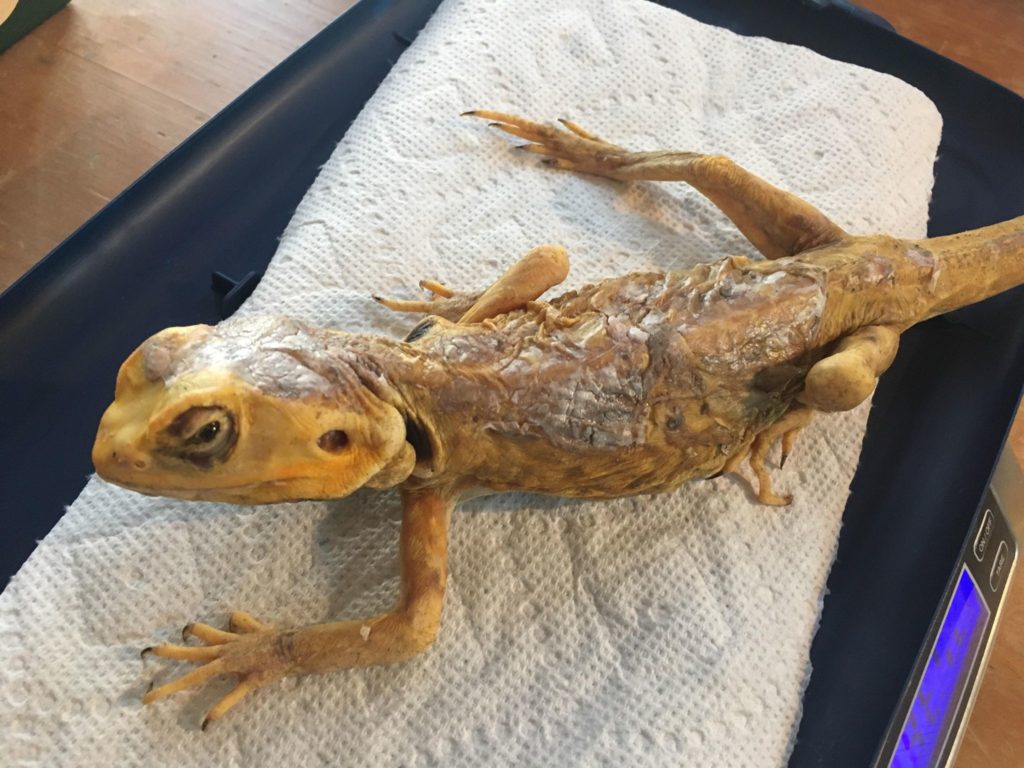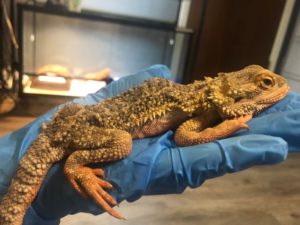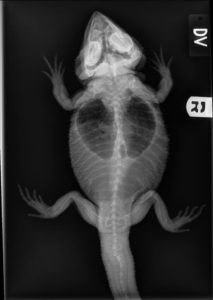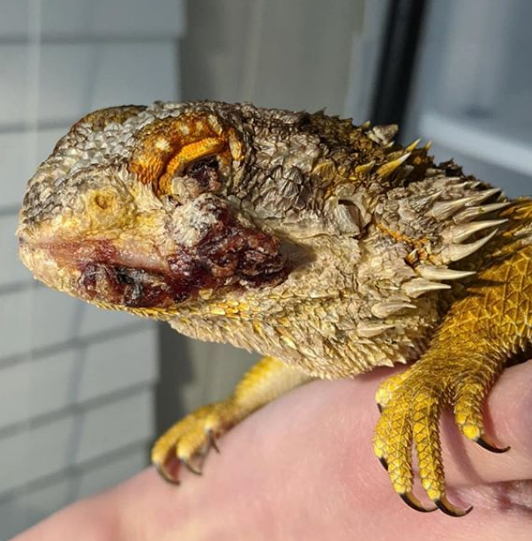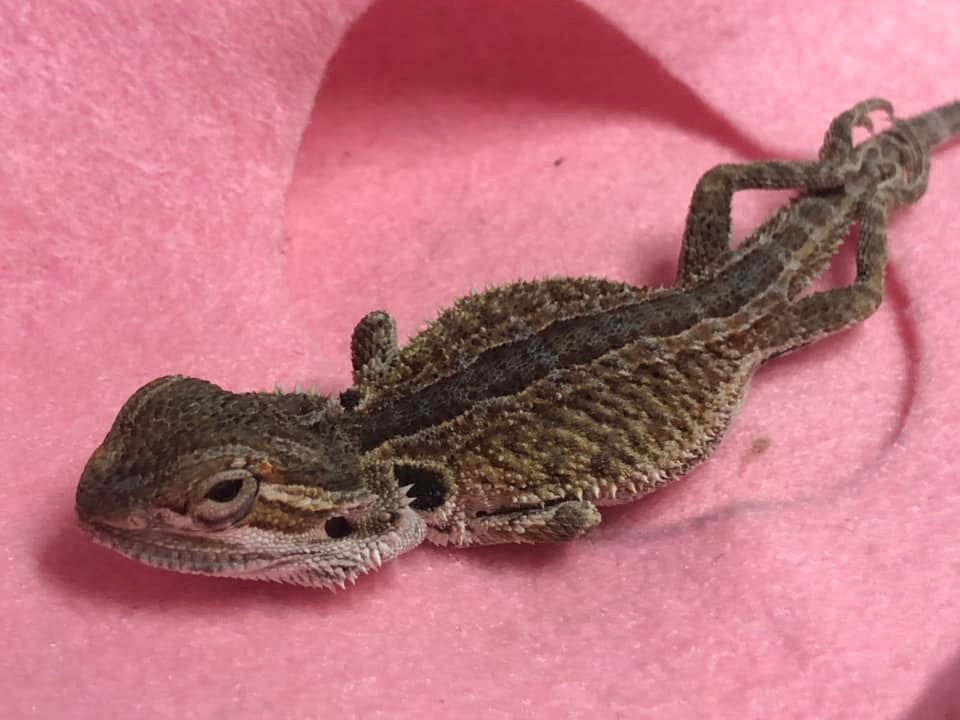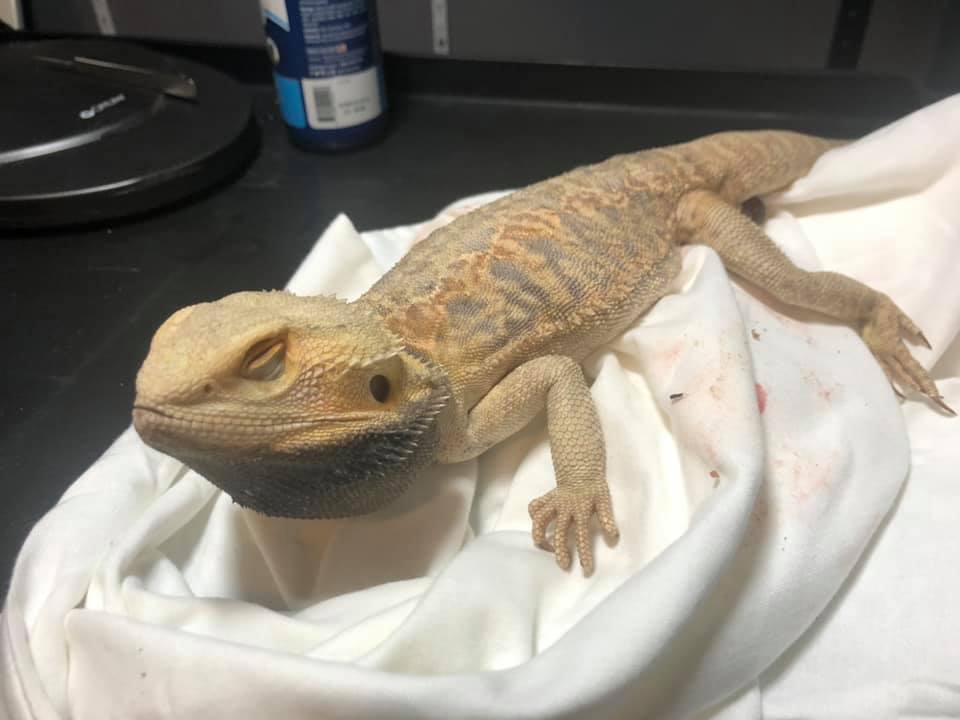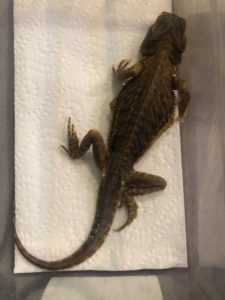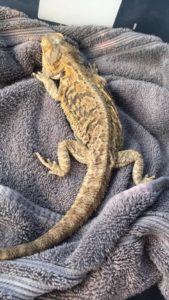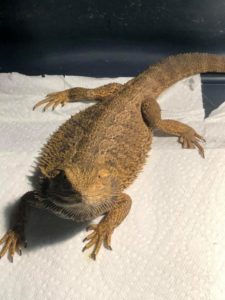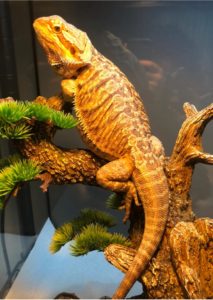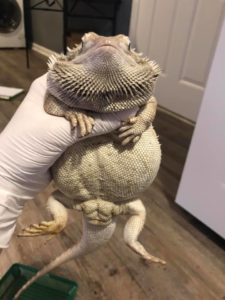BEARDED DRAGON
Caging
We consider a 40 gallon tank to be the absolute bare minimum for an adult bearded dragon and ideally you should provide them with more space. However, we have found 40 gallons to be suitable for some senior bearded dragons and for dragons with mobility issues. Preferable cage sizes include a 75 gallon tank or a 120 gallon (4’x2’x2’) tank or enclosure. The bigger the better! You can assess how much space your bearded dragon needs by its size and activity level. Young bearded dragons can be kept in 20 or 40 gallon enclosures.
Decor
At least one basking spot is an absolute must. Climbing structures can be added for additional enrichment, many seem to enjoy hammocks. Bearded dragons can be pretty active, so it’s preferable to provide them with a decent amount of open space. Some also appreciate an enclosed area to hide and sleep in.
Substrate
Our recommended substrates are paper towel, tile, shelf liner, or a sand/soil bioactive mixture. Our personal favorite is tile or shelf liner. It is safe, attractive, and easy to clean. Paper towels or brown craft paper are great for new bearded dragons that are still being quarantined. A sand/soil mixture is a good option when used in a bioactive enclosure with an established clean up crew. We recommend that beginners start with a non-particulate substrate, as a particulate substrate (such as a sand/soil mixture) can cause impaction issues if the owner has an incorrect basking temperature or is feeding unsafe foods. The owner should also take the time to learn about bioactive cycles, culture arid isopods and springtails, and establish a bioactivity community before attempting this with their bearded dragon.
We do not recommend reptile carpet, walnut shell, or calcium sand. Reptile carpet promotes an unclean environment as bearded dragon feces are very messy and not easy to clean off of carpet. It has to be completely removed and washed whenever the dragon defecates, and doing this daily is not practical. Walnut shell is an abrasive material that can cause impaction and bleeding if ingested, and calcium sand can solidify in the gastrointestinal tract and cause impaction. Wood chips/shavings are also not recommended, as these larger pieces can cause impaction and these materials are difficult to keep clean or establish in a bioactive environment.
Heating
Bearded dragons should be provided with a basking spot under a heat lamp. A variety of different basking bulbs can be used and you may have to play around with the wattage to get the temperature right, based on your enclosure height, lid material, and basking platform. You can use an infrared temperature gun (available on Amazon) to reliably measure the temperature. Juvenile bearded dragons should be provided with a hot spot of 110°F – 115°F. An adult’s basking spot should be 100°F – 105°F. As long as the temperature stays above 65°F, all lights and heating elements can be turned off at night. A nighttime temperature drop can actually improve their sleep cycle and is beneficial to their overall health. If the room temperature drops below 65°F at night, a ceramic heat emitter or deep heat projector can be used, as they produce heat without producing light.
Lighting
In most cases, the ideal UVB light for a bearded dragon is a 10.0 T5 HO UVB linear bulb. Popular brands include Arcadia and the Zoo Med Reptisun. Some keepers use T8 bulbs, but T5 bulbs emit stronger UVB and are more appropriate for species that require high levels of UVB. However, if you are mounting your UVB light inside the enclosure rather than on top of a screen lid, you may want to consider using a T8 instead. UVB bulbs should be replaced every 6-12 months depending on type and brand, as they will stop emitting UVB.
Diet
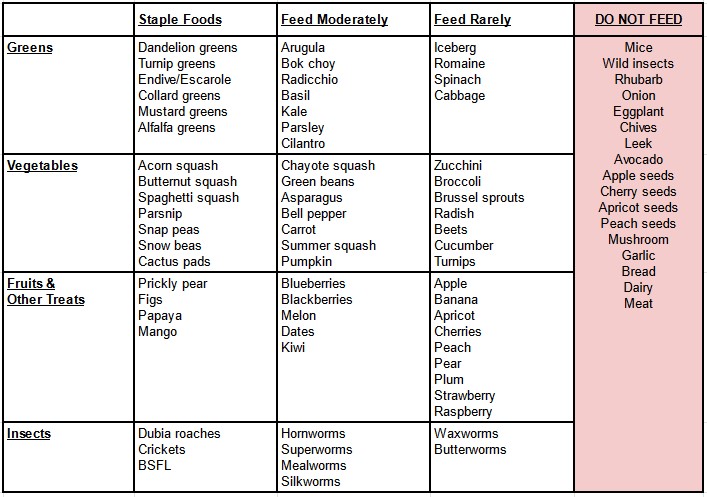

Supplementation
Supplements are typically offered via a powder that is dusted on the insects. This is done by adding some of the powder to a bag or cup, and shaking the insects in the powder. Our preferred supplement is Repashy Calcium Plus, which has both calcium and a multivitamin. Repashy Calcium Plus is designed to be used with every insect feeding. If you are not using Repashy Calcium Plus, for adult bearded dragons you can offer calcium without D3 twice a week and a multivitamin supplement once per week. Juveniles should be offered calcium every feeding, and multivitamins twice a week. We recommend avoiding supplements you add to their water, as this dilutes the supplement making it harder to control the amount. Bearded dragons also do not reliably drink water. We have seen metabolic bone disease develop in lizards only offered calcium in their water.
Water
A large bowl of fresh water should always be provided. It should be big enough for them to soak in should they choose. Some keepers don’t believe in providing a water bowl. However, we have had many bearded dragons surrendered from owners who chose not to provide one and those animals are always eager to drink when they arrive. They’ll often drink for several minutes! High humidity and respiratory infections are not a concern of ours when using a water bowl in a bearded dragon enclosure. Most enclosures have screen lids, which rapidly dissipate humidity. Additionally, a 100+°F hot spot will quickly zap humidity. We have never had a bearded dragon surrendered with a respiratory infection.
Things You Should NOT Do
- Pinkie Mice – Feeding pinkies to bearded dragons is a controversial topic because they are very high in fat.
- Romaine and Iceburg – These greens aren’t dangerous, just very low in nutrition.
- Spinach – Spinach is very high in oxalates, which bind to calcium and prevent the body from fully absorbing it.
- Kale – Kale can be fed in moderation, but too many keepers still use it as a staple green. Kale is high in goitrogens, which can negatively impact a bearded dragon’s thyroid.
- Wild Insects – Wild insects are often infested with parasites that can infect your bearded dragon. They can also have ingested pesticides.
Common Health Issues
Aneurysm: Aneurysms are rare in bearded dragons but are occasionally seen. Their cause is likely genetic weakening of the blood vessels, so they cannot be prevented. If your dragon suffers a large internal aneurysm, they will typically die quickly from internal blood loss. One common area for an aneurysm is the side of the head, which is when the cranial mesenteric artery has a weakened wall. If your dragon has a large swelling here, it is possible the aneurysm burst and then clotted. Unfortunately, prognosis is poor and surgeries attempting vessel resection are often unsuccessful. There have been a few successful cases, but long-term survival is limited.
Burns: Burns are possible with any heat source, though heat rocks are known to often cause burns as they are unregulated. A heat rock should NEVER be used for any animal. A heat lamp can also cause burns if it is too close to the heat source or at a high enough wattage. Make sure to measure the temperature of your basking spot regularly. If your bearded dragon has a burn, see a vet to assess severity and obtain the proper medications for treatment, such as anti-inflammatories and silver sulfadiazine cream.
Hepatic lipidosis: This is the term for “fatty liver disease,” and is a common malady in overweight reptiles. This is common in bearded dragons fed high-fat diets, such as waxworms, superworms, and mealworms. Superworms can definitely be used as a part of a balanced diet, but waxworms are especially high in fat and should only be fed sparingly. If a dragon gets too much fat in the diet, the body cannot process it all and fat starts to deposit in the liver. In advanced cases, this causes anorexia, fluid buildup in the body, regurgitation, and death. See a veterinarian if you are concerned your dragon has hepatic lipidosis. They will likely recommend a diet change, liver supplements, and feeding consistent amounts of low-fat foods. As a reminder, adult bearded dragons should be eating 80% greens and vegetables, and only a limited amount of insects and fruits.
Prolapse: Cloacal prolapses can happen in both male and female dragons, but male dragons can also develop hemipenal prolapses. Prolapses are a very serious medical condition and should be considered an emergency situation. Bearded dragons suffering from a prolapse should see a veterinarian immediately. If it is recent, sometimes the vet can push the prolapsed tissue back in and place a temporary suture, but advanced prolapses can become infected and necrotic. Some prolapses will require amputation.

